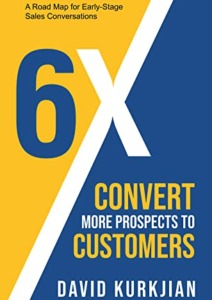How to avoid the three mistakes salespeople make in the early stages of the sales cycle
The sales cycle is the process that salespeople follow to generate leads, qualify prospects, and close deals. It is a complex process with many different stages, but the early stages are arguably the most important. This is where you first meet the prospect and start to build a relationship with them. It is also where you need to qualify the prospect and make sure that they are a good fit for your product or service.
If you make a mistake in the early stages of the sales cycle, it can be very difficult to recover. That is why it is important to be aware of the common mistakes that salespeople make and how to avoid them.
In this blog post, we will discuss three of the most common mistakes that salespeople make in the early stages of the sales cycle:
- Sharing too much information
- Not being unique in the conversation
- Not focusing on the prospect’s point of view
Mistake #1: Sharing too much information
One of the most common mistakes that salespeople make in the early stages of the sales cycle is sharing too much information. This can be tempting, especially if you are eager to show the prospect how much you know about your product or service. However, it is important to remember that the prospect is not there to listen to a sales pitch. They are there to learn more about how your product or service can help them solve a problem or achieve a goal.
When you share too much information, it can overload the prospect and lead to confusion. It can also make it difficult for the prospect to focus on the unique value that your product or service can offer them.
How to avoid it:
- Focus on the prospect’s needs and communicate the value of your product or service in a way that is compelling and memorable.
- Ask questions to learn more about the prospect’s challenges and goals.
- Tailor your message to the prospect’s specific needs.
- Don’t be afraid to say “I don’t know” if you don’t have an answer to a question. You can always follow up and provide the answer later.
Mistake #2: Not being unique in the conversation
Another common mistake that salespeople make in the early stages of the sales cycle is not being unique in the conversation. This is especially important for companies in commoditized industries. If you are selling a product or service that is similar to what other companies are selling, you need to find a way to stand out from the competition.
One way to do this is to focus on what makes your product or service unique. What are the benefits that only your product or service can offer? What problems can your product or service solve that other products or services cannot?
Another way to be unique in the conversation is to tell stories. Stories are a powerful way to connect with people and engage their emotions. When you tell stories about how your product or service has helped other customers, it shows the prospect that you understand their needs and that you can help them achieve their goals.
How to avoid it:
- Look for ways to combine seemingly ordinary products or services to create something unique.
- Focus on the benefits that only your product or service can offer.
- Tell stories about how your product or service has helped other customers.
- Use analogies and metaphors to explain your product or service in a way that is easy to understand.
Mistake #3: Not focusing on the prospect’s point of view
The third common mistake that salespeople make in the early stages of the sales cycle is not focusing on the prospect’s point of view. This can lead to misunderstandings and resentment.
It is important to remember that the prospect is not there to listen to a sales pitch. They are there to learn more about how your product or service can help them solve a problem or achieve a goal. When you focus on the prospect’s point of view, you can better understand their needs and communicate the value of your product or service in a way that is relevant to them.
One way to focus on the prospect’s point of view is to ask questions. Ask the prospect about their challenges, their goals, and what they are looking for in a solution. The more you know about the prospect’s point of view, the better equipped you will be to communicate the value of your product or service in a way that is relevant to them.
Another way to focus on the prospect’s point of view is to use empathy. Empathy is the ability to understand and share the feelings of another person. When you are empathetic, you are able to see the world from the prospect’s perspective and understand their needs and concerns.
How to avoid it:
- Use active listening. Active listening is more than just hearing what the prospect is saying. It is also about paying attention to their body language and tone of voice, and asking clarifying questions to make sure you understand their needs.
- Be mindful of your language. Avoid using jargon or technical terms that the prospect may not understand. Instead, use plain language that is easy to understand.
- Be respectful of the prospect’s time. Don’t ramble on about your product or service without first understanding the prospect’s needs. Get to the point quickly and efficiently.
- Be responsive to the prospect’s feedback. When the prospect provides feedback, take the time to listen to them and address their concerns. This shows that you are genuinely interested in helping them solve their problems.
By following these tips, you can focus on the prospect’s point of view and build a relationship with them that is based on trust and understanding.






Comments